Potrebujeme váš súhlas na využitie jednotlivých dát, aby sa vám okrem iného mohli ukazovať informácie týkajúce sa vašich záujmov. Súhlas udelíte kliknutím na tlačidlo „OK“.
ASTM D2992-12
Standard Practice for Obtaining Hydrostatic or Pressure Design Basis for “Fiberglass” (Glass-Fiber-Reinforced Thermosetting-Resin) Pipe and Fittings
Automaticky preložený názov:
Štandardná prax pre získanie hydraulický alebo tlaku dizajn základom pre a ldquo, CSF-rdquo; (Sklenými vláknami vystužený Teplom-živice), rúrky a armatúry
NORMA vydaná dňa 1.4.2012
Informácie o norme:
Označenie normy: ASTM D2992-12
Poznámka: NEPLATNÁ
Dátum vydania normy: 1.4.2012
Kód tovaru: NS-22202
Počet strán: 11
Približná hmotnosť: 33 g (0.07 libier)
Krajina: Americká technická norma
Kategória: Technické normy ASTM
Kategórie - podobné normy:
Anotácia textu normy ASTM D2992-12 :
Keywords:
closure, cyclic pressure, design basis, fiberglass pipe, reconfirmation, static pressure , Fiberglass pipe, Glass-fiber-reinforced thermosetting resin (&ldquo,fiberglass&rdquo,), Hoop stress test, Hydrostatic design basis (HDB), Hydrostatic testing, Long-term hydrostatic strength/pressure, PDB (pressure design basis), Pressure design basis (PDB), Pressure testing--plastic pipe/tube, Pressure versus cycles/time to failure, Reinforced thermosetting-resin pipe (RTRP)
Doplňujúce informácie
| Significance and Use | ||||||||||||||||||||
|
This practice is useful for establishing the hoop stress or internal pressure versus time-to-failure relationships, under selected internal and external environments which simulate actual anticipated product end-use conditions, from which a design basis for specific piping products and materials can be obtained. This practice defines an HDB for material in straight, hollow cylindrical shapes where hoop stress can be easily calculated, and a PDB for fittings and joints where stresses are more complex. An alternative design practice based on initial strain versus time-to-failure relationships employs a strain basis HDB instead of the stress basis HDB defined by this practice. The strain basis HDB is most often used for buried pipe designs with internal pressures ranging from 0 to 250 psig (1.72 MPa). To characterize fiberglass piping products, it is necessary to establish the stress versus cycles or time to failure, or pressure versus cycles or time to failure relationships over three or more logarithmic decades of time (cycles or hours) within controlled environmental parameters. Because of the nature of the test and specimens employed, no single line can adequately represent the data. Therefore, the confidence limits should be established. Pressure ratings for piping of various dimensions at each temperature may be calculated using the HDS determined by testing one size of piping provided that the same specific process and material are used both for test specimens and the piping in question. Pressure ratings at each temperature for components other than straight hollow shapes may be calculated using the HDP determined by testing one size of piping provided that (1) the specific materials and manufacturing process used for the test specimens are used for the components, (2) for joints, the joining materials and procedures used to prepare the test specimens are used for field joining, and (3) scaling of critical dimensions is related to diameter and pressure rating of the component. Note 8—Scaling of fittings and joints should be further verified by short-time testing in accordance with Test Method D1599. Results obtained at one set of environmental conditions should not be used for other conditions, except that higher temperature data can be used for design basis assignment for lower application temperatures. The design basis should be determined for each specific piping product. Design and processing can significantly affect the long-term performance of piping products, and therefore should be taken into consideration during any evaluation. This practice is valid for a given pipe or fitting only so long as the specimens are truly representative of that material and manufacturing process. Changes in materials or manufacturing processes will necessitate a reevaluation as described in Section 12. PROCEDURE ATop
|
||||||||||||||||||||
| 1. Scope | ||||||||||||||||||||
|
1.1 This practice establishes two procedures, Procedure A (cyclic) and Procedure B (static), for obtaining a hydrostatic design basis (HDB) or a pressure design basis (PDB) for fiberglass piping products, by evaluating strength-regression data derived from testing pipe or fittings, or both, of the same materials and construction, either separately or in assemblies. Both glass-fiber-reinforced thermosetting-resin pipe (RTRP) and glass-fiber-reinforced polymer mortar pipe (RPMP) are fiberglass pipe. Note 1—For the purposes of this standard, polymer does not include natural polymers. 1.2 This practice can be used for the HDB determination for fiberglass pipe where the ratio of outside diameter to wall thickness is 10:1 or more. Note 2—This limitation, based on thin-wall pipe design theory, serves further to limit the application of this practice to internal pressures which, by the hoop-stress equation, are approximately 20 % of the derived hydrostatic design stress (HDS). For example, if HDS is 5000 psi (34 500 kPa), the pipe is limited to about 1000-psig (6900-kPa) internal pressure, regardless of diameter. 1.3 This practice provides a PDB for complex-shaped products or systems where complex stress fields seriously inhibit the use of hoop stress. 1.4 Specimen end closures in the underlying test methods may be either restrained or free, leading to certain limitations. 1.4.1 Restrained Ends—Specimens are stressed by internal pressure only in the hoop direction, and the HDB is applicable for stresses developed only in the hoop direction. 1.4.2 Free Ends—Specimens are stressed by internal pressure in both hoop and longitudinal directions, such that the hoop stress is twice as large as the longitudinal stress. This practice may not be applicable for evaluating stresses induced by loadings where the longitudinal stress exceeds 50 % of the HDS. 1.5 The values stated in inch-pound units are to be regarded as the standard. The values in parentheses are given for information purposes only. Note 3—There is no known ISO equivalent to this standard. 1.6 This standard does not purport to address all of the safety concerns, if any, associated with its use. It is the responsibility of the user of this standard to establish appropriate safety and health practices and determine the applicability of regulatory limitations prior to use. |
||||||||||||||||||||
| 2. Referenced Documents | ||||||||||||||||||||
|
Podobné normy:
Historická
1.8.2010
Historická
25.4.2014
Historická
15.11.2011
Historická
1.8.2012
Historická
1.8.2011
Historická
1.5.2014


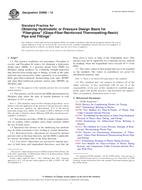
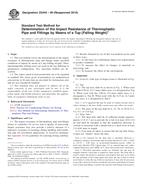 ASTM D2444-99(2010)..
ASTM D2444-99(2010)..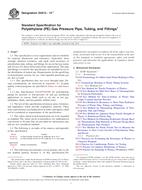 ASTM D2513-14e1
ASTM D2513-14e1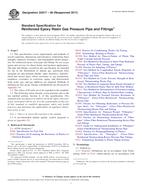 ASTM D2517-06(2011)..
ASTM D2517-06(2011)..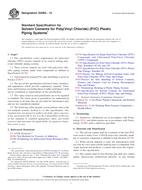 ASTM D2564-12
ASTM D2564-12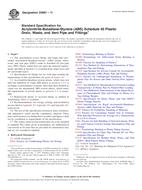 ASTM D2661-11
ASTM D2661-11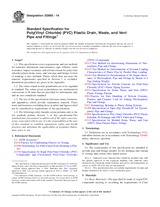 ASTM D2665-14
ASTM D2665-14
 Cookies
Cookies
